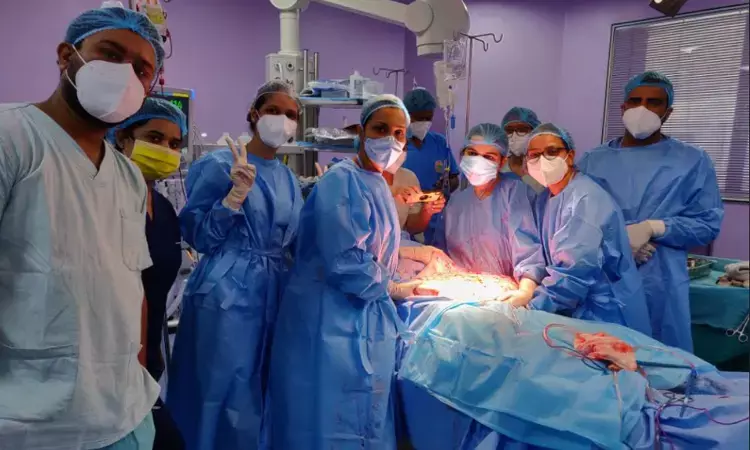- Home
- Medical news & Guidelines
- Anesthesiology
- Cardiology and CTVS
- Critical Care
- Dentistry
- Dermatology
- Diabetes and Endocrinology
- ENT
- Gastroenterology
- Medicine
- Nephrology
- Neurology
- Obstretics-Gynaecology
- Oncology
- Ophthalmology
- Orthopaedics
- Pediatrics-Neonatology
- Psychiatry
- Pulmonology
- Radiology
- Surgery
- Urology
- Laboratory Medicine
- Diet
- Nursing
- Paramedical
- Physiotherapy
- Health news
- Fact Check
- Bone Health Fact Check
- Brain Health Fact Check
- Cancer Related Fact Check
- Child Care Fact Check
- Dental and oral health fact check
- Diabetes and metabolic health fact check
- Diet and Nutrition Fact Check
- Eye and ENT Care Fact Check
- Fitness fact check
- Gut health fact check
- Heart health fact check
- Kidney health fact check
- Medical education fact check
- Men's health fact check
- Respiratory fact check
- Skin and hair care fact check
- Vaccine and Immunization fact check
- Women's health fact check
- AYUSH
- State News
- Andaman and Nicobar Islands
- Andhra Pradesh
- Arunachal Pradesh
- Assam
- Bihar
- Chandigarh
- Chattisgarh
- Dadra and Nagar Haveli
- Daman and Diu
- Delhi
- Goa
- Gujarat
- Haryana
- Himachal Pradesh
- Jammu & Kashmir
- Jharkhand
- Karnataka
- Kerala
- Ladakh
- Lakshadweep
- Madhya Pradesh
- Maharashtra
- Manipur
- Meghalaya
- Mizoram
- Nagaland
- Odisha
- Puducherry
- Punjab
- Rajasthan
- Sikkim
- Tamil Nadu
- Telangana
- Tripura
- Uttar Pradesh
- Uttrakhand
- West Bengal
- Medical Education
- Industry
Surgery effective treatment option for relieving symptoms of frontoethmoid osteomas

Surgery was a very effective treatment to resolve the symptoms caused by frontoethmoid osteomas, according to the latest research published in the Journal of Otolaryngology and Rhinology.
Osteomas are benign tumors that can originate and grow in the paranasal sinuses. Many are asymptomatic and only require tomographic control. When they produce symptoms, treatment is surgical. Different surgical approaches have been proposed, with a trend in the last decade to perform endonasal surgery with endoscopes using simple, extended or combined transnasal approaches.
Carlos Santiago Ruggeri et. al tried to determine the efficacy of surgery to resect symptomatic frontoethmoidal osteomas, and to establish the factors that could facilitate an endonasal approach with endoscopes.
All patients who were surgically treated for osteomas located in the ethmoid and frontal sinuses between August 2007 and June 2021 in the Rhinosinusology section of the Otorhinolaryngology Service of the Hospital Italiano de Buenos Aires were included.
All the operated patients had symptoms caused by the bone neoplasm. Those who suffered from craniofacial pain consulted neurology prior to surgery to rule out other types of headaches.
They were evaluated by nasal endoscopy and computed tomography without contrast (CT). A measurement of the size of the osteoma was performed on the tomography and the extension and its possible implantation (Chiu classification) were analyzed.
The surgical technique varied according to the paranasal sinus involved, the location within the sinus, and the size of the tumor. In ethmoid osteomas, an endonasal approach was performed with endoscopes.
An anterior ethmoidectomy was performed and the osteomas were resected and in another, the osteoma was drilled to reduce its size. In frontal osteomas, an endonasal approach was performed with endoscopes (Draf II-a, and Lothrop modified technique) and osteoplastic surgery without obliteration. All patients were hospitalized for 24 hours and there were no complications. Controls were performed by nasal endoscopy and computed tomography.
The authors listed the following results:
1. Seven patients were surgically treated for symptomatic frontoethmoidal osteomas.
2. Four were located in the frontal sinus, two in the anterior ethmoid, and one in the anterior and posterior ethmoid and sphenoid.
3. Five were treated by endonasal approach with endoscopes and two with osteoplastic technique without frontal sinus obliteration.
4. Symptoms improved in all patients.
"The endonasal approach with endoscopes is of choice to treat ethmoidal osteomas. In frontal osteomas, the total occupation of the sinus, the lateral location, and the extensive implantation are factors to consider in the choice of external approaches, although they do not exclude the indication of an extended endonasal approach with the cavitation technique or a combined approach," the authors concluded.
B.Sc Life Sciences, M.Sc Biotechnology, B.Ed
Isra Zaman is a Life Science graduate from Daulat Ram College, Delhi University, and a postgraduate in Biotechnology from Amity University. She has a flair for writing, and her roles at Medicaldialogues include that of a Sr. content writer and a medical correspondent. Her news pieces cover recent discoveries and updates from the health and medicine sector. She can be reached at editorial@medicaldialogues.in.
Dr Kamal Kant Kohli-MBBS, DTCD- a chest specialist with more than 30 years of practice and a flair for writing clinical articles, Dr Kamal Kant Kohli joined Medical Dialogues as a Chief Editor of Medical News. Besides writing articles, as an editor, he proofreads and verifies all the medical content published on Medical Dialogues including those coming from journals, studies,medical conferences,guidelines etc. Email: drkohli@medicaldialogues.in. Contact no. 011-43720751


